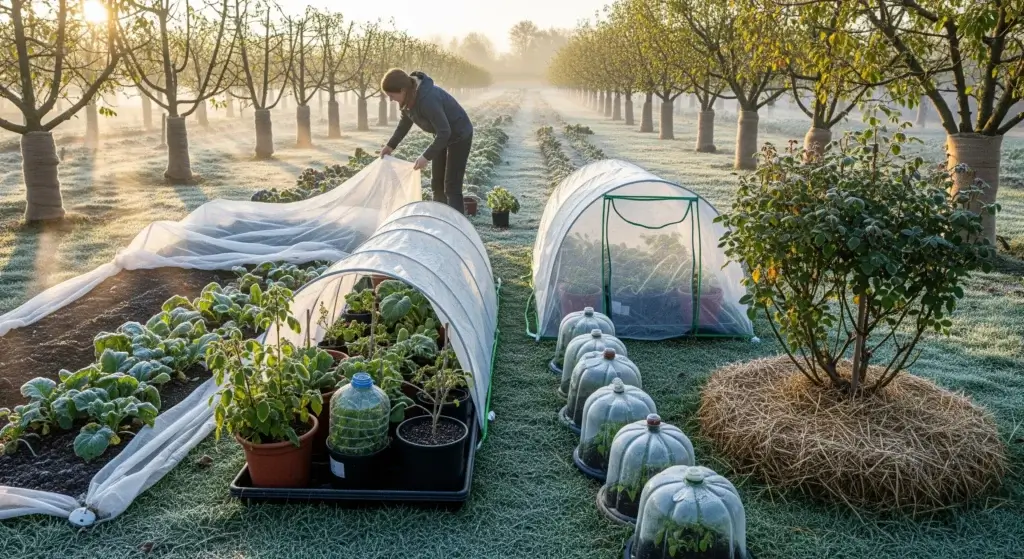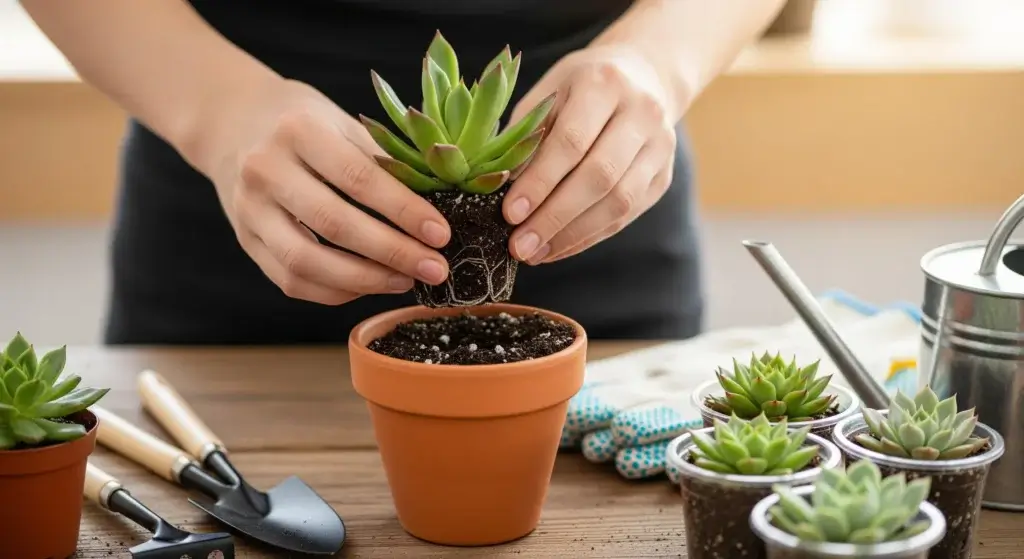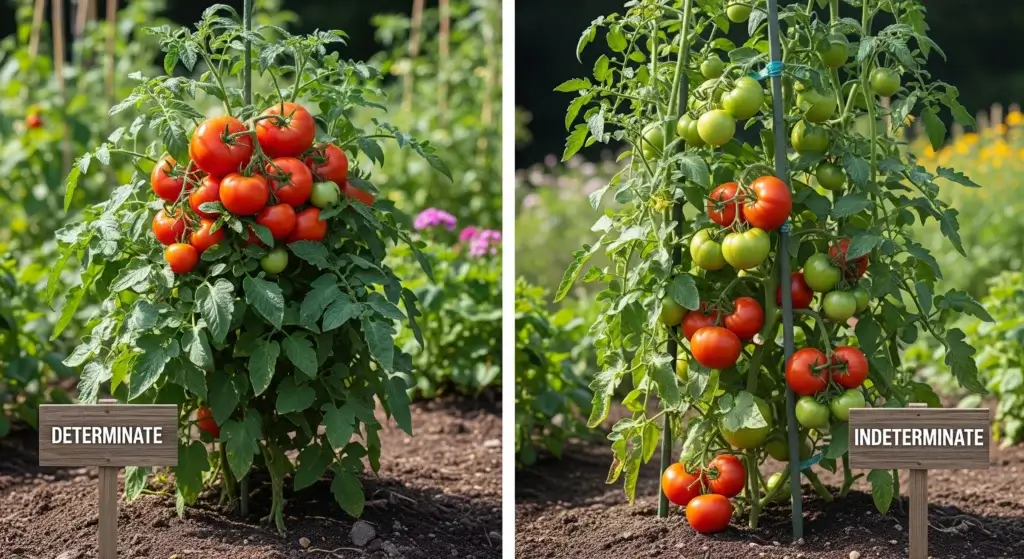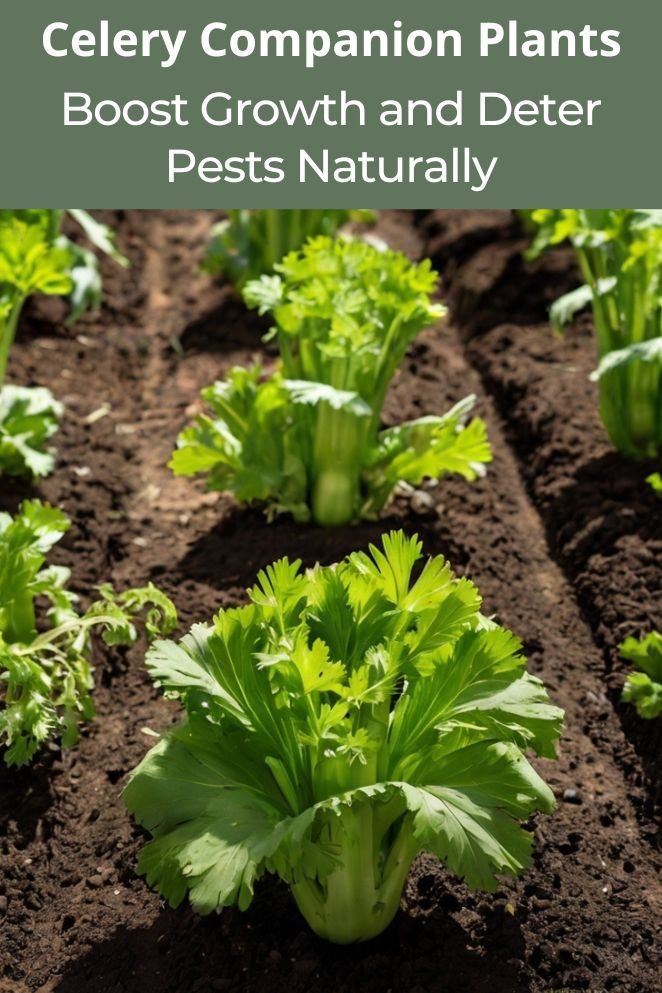
Celery’s a bit of a diva—needs water, attention, and zero stress to shine.
But pair it with the right garden buddies, and suddenly it’s thriving like a star on a good PR day.
Companion planting is the hack: some plants fight off pests, others boost its growth vibe.
In this guide, we’ll dish out the best BFFs (and drama queens to avoid) so your celery can live its best garden life—no tantrums, just crisp success.
Benefits of Companion Planting with Celery
Companion planting with celery is like setting it up with the ultimate support squad—think of it as a garden version of assembling the Avengers.
Here’s the behind-the-scenes magic:
Pest control
Some plants are like celery’s personal security guards.
For example, strong-smelling herbs like thyme or mint act like natural bug spray, driving away aphids, carrot flies, and other creepy crawlies that love to snack on celery leaves.
It’s like having a garlic necklace, but for your plants.
Improved soil health
Plants like beans and peas are natural soil-enhancers.
They fix nitrogen in the soil, which is kind of like giving your celery a bottomless smoothie of plant nutrients.
More nitrogen = better growth = happier celery.
Enhanced growth
Tall or leafy companion plants like leeks or cabbage can act as shade or windbreaks.
Celery’s a bit sensitive to too much sun or wind (remember: diva), so creating a cozy microclimate helps it stay lush and crisp instead of sad and floppy.
Attracting beneficial insects
Some flowers and herbs—like marigolds, dill, or cosmos—don’t just make the garden pretty.
They roll out the red carpet for beneficial insects like ladybugs, lacewings, and parasitic wasps (aka pest assassins). These bugs take care of aphids and other villains so your celery can focus on thriving.
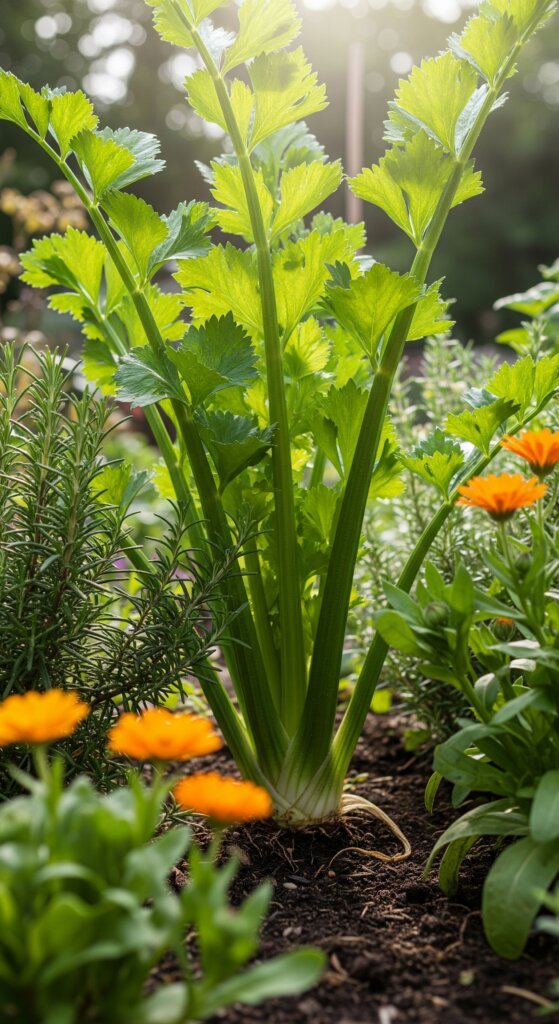
Top Celery Companion Plants
Alright, let’s talk about celery’s ultimate garden squad—those companion plants that have its back like loyal sidekicks.
Plant these pals nearby, and your celery will feel the love with fewer pests, better growth, and a cooler vibe overall.
Here’s the lowdown on celery’s best BFFs:
1. Beans and peas
Beans and peas are like the eco-friendly gardeners of the soil world.
They capture nitrogen from the air and drop it into the soil like little nutrient bombs—perfect for celery, which is a bit of a heavy feeder.
Plus, pole beans can grow tall and cast some welcome shade, giving your celery a break from the blazing sun.
Think of them as the cool umbrellas on a hot day.
2. Brassicas (cabbage, broccoli, cauliflower)
Celery’s strong aroma is basically like a natural bug repellent, keeping pests like cabbage moths away from its brassica neighbors.
In return, these taller plants offer celery some shade and protection from too much sun.
It’s a win-win, like a garden buddy cop duo watching each other’s backs.
3. Alliums (onions, garlic, leeks, chives)
Alliums bring their pungent smell to the party, which pests like aphids, slugs, and snails find super annoying—so they steer clear.
Bonus points: alliums don’t dig too deep with their roots, so they don’t steal nutrients from celery.
They’re like the noisy neighbors who keep the bad guys away but don’t hog the good stuff.
4. Tomatoes
Tomatoes and celery are like peanut butter and jelly—both love similar growing conditions and can help each other thrive.
They share pest control duties and growth benefits, making your garden feel like a well-oiled machine.
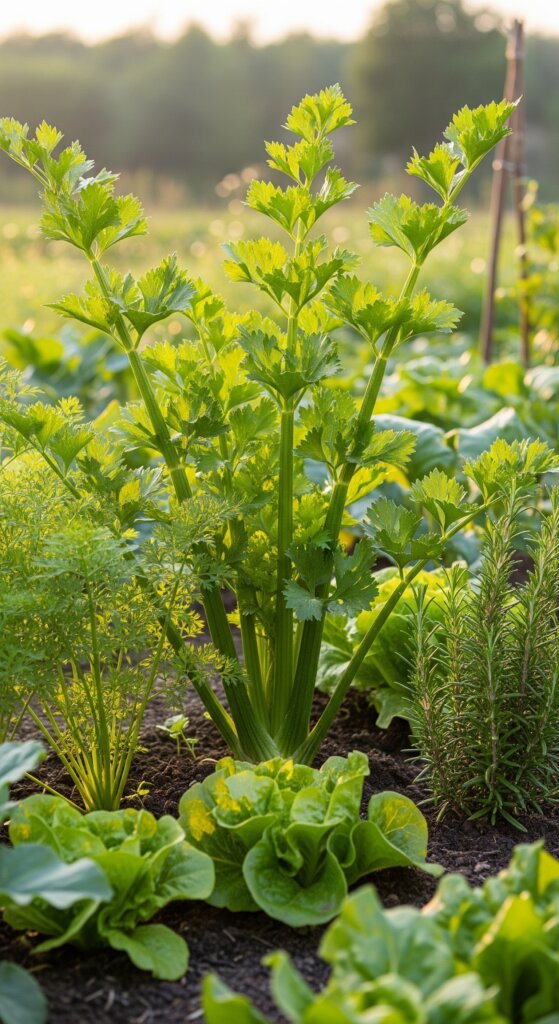
5. Spinach and lettuce
These leafy greens work as a natural mulch, suppressing weeds and locking moisture into the soil.
Plus, they keep celery cozy and prevent its roots from drying out.
Think of them as the cozy sweaters your celery loves to wear.
6. Cucumbers
Cucumber vines spread out like a green carpet, keeping weeds down and soil moist.
Meanwhile, celery steps up by deterring pesky whiteflies that might bother cucumbers.
It’s like a buddy system—both watching out for each other.
7. Herbs (dill, chamomile, mint, oregano)
Herbs bring double benefits: mint and oregano throw off pests with their strong scents (just keep mint in pots unless you want it to take over your garden), while dill and chamomile attract beneficial insects like parasitic wasps and hoverflies that feast on aphids.
It’s like hosting a bug party where only the good guys are invited.
8. Flowers (marigolds, nasturtiums, cosmos)
These flowers are more than eye candy.
Marigolds and nasturtiums act as decoys, drawing pests away from celery like a garden version of “The Bachelorette” with all the drama but none of the bugs.
Cosmos attract helpful insects that keep the pest population in check—nature’s pest control squad in floral form.
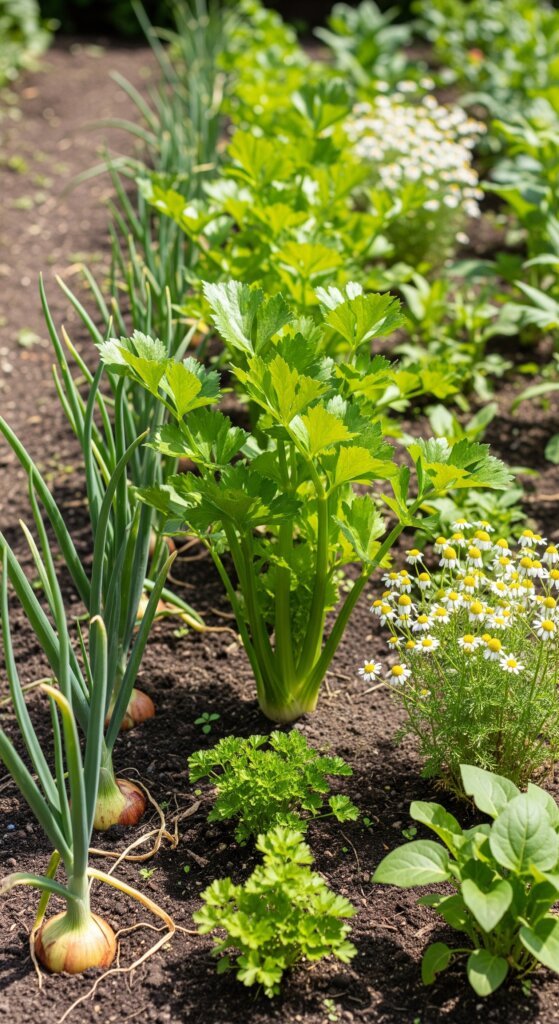
Plants to Avoid Near Celery
Alright, now that we’ve got celery’s best friends down, let’s talk about the plants that definitely don’t make the cut.
These are the garden frenemies that can mess with your celery’s vibe, stunt its growth, or even invite trouble.
Here’s the scoop on who to keep far, far away from your stalk star:
1. Carrots and parsnips
Carrots and parsnips might look harmless, but they’re basically competing with celery for the same snacks—nutrients in the soil.
Plus, they attract a lot of the same pests, turning your garden into a hotspot for uninvited guests.
It’s like having two drama queens fighting over the spotlight.
2. Potatoes
Potatoes aren’t just hogging soil nutrients; they’re also potential carriers of diseases that celery really doesn’t want to catch.
Keeping potatoes too close is like inviting a cold into your house when you’re already fighting off the flu.
3. Corn
Corn grows tall and proud, but it tends to throw a serious shade—literally.
Its height can block sunlight from reaching your celery, which thrives on bright, consistent light.
Imagine trying to work out while someone’s holding a giant umbrella over your head—yeah, not ideal.
4. Fennel
Fennel is the ultimate party pooper in the garden world.
It releases chemicals that can stunt the growth of nearby plants—including your precious celery.
Think of fennel as that one friend who’s jealous of everyone’s success and tries to bring them down.
Tips for Successful Companion Planting with Celery
Alright, if you want your celery and its plant buddies to play nice and thrive, here’s the lowdown on how to ace companion planting like a pro — without turning your garden into a chaotic jungle.
Plan your garden layout
Think of your garden like a dinner party.
You don’t just shove everyone together randomly, right? You want the chatty plants that get along (like celery and beans) sitting close, while the drama queens stay separated.
Consider how tall each plant grows, how much space their roots need, and their sun and water needs.
Giving each plant its personal bubble keeps everyone happy and thriving.
Monitor soil moisture
Celery is like that friend who’s always thirsty—seriously, it needs consistent moisture to look its best.
Mulch is your secret weapon here.
It helps lock in water and keeps weeds from stealing the spotlight (and nutrients).
Think of mulch as a cozy blanket for your soil, holding in all the good stuff.
Rotate crops
Planting celery in the same spot every year? Big no-no.
It’s like playing the same song on repeat—soil gets tired, pests start crashing the party, and diseases can sneak in.
Mixing things up by rotating crops each season keeps the soil fresh and the bad bugs guessing.
Use containers for invasive herbs
Some herbs, like mint, are basically the garden’s version of that one friend who can’t take a hint—they spread everywhere and take over.
Keep these rowdy herbs in containers to keep their enthusiasm in check. Pots give them a boundary, so your celery and other plants get the space they need without being crowded out.

Conclusion
Companion planting isn’t just old gardening wisdom—it’s like assembling the ultimate squad for your celery.
The right plant buddies can kick pests to the curb, boost soil vibes, and turn your garden into a thriving, happy community.
Just plan smart, keep an eye on what your plants need, and watch your green crew flourish. Gardening goals, unlocked!

